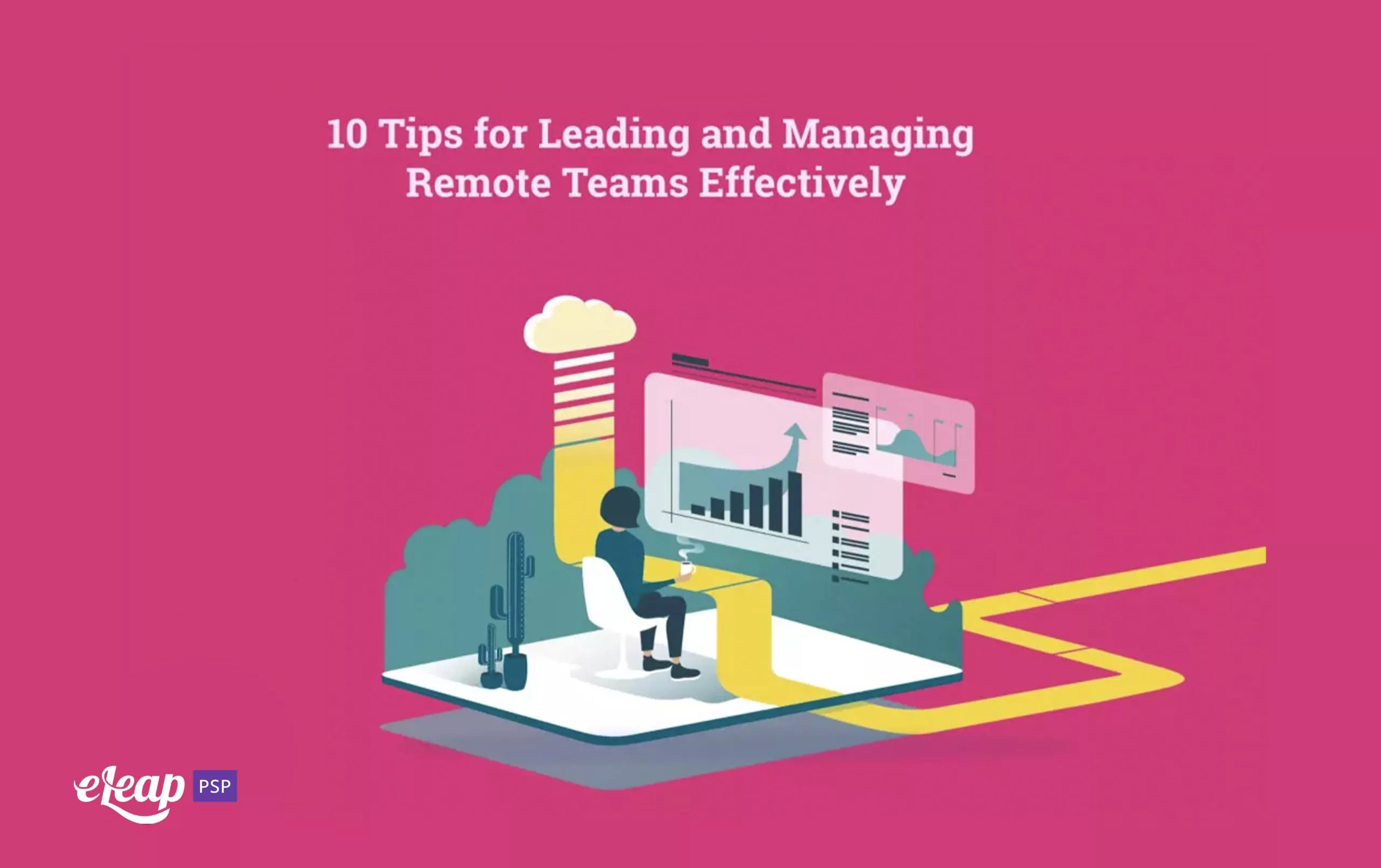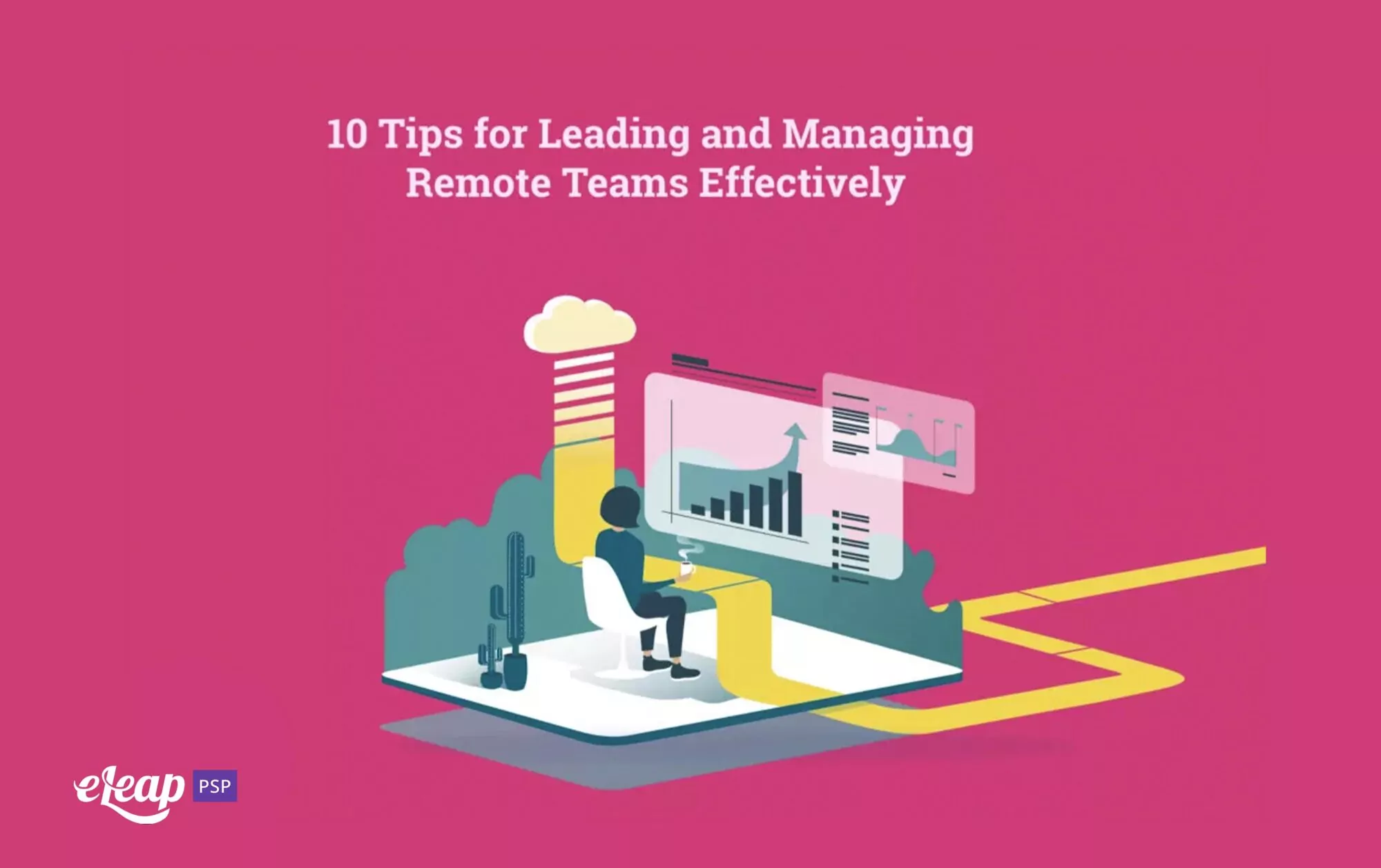10 Tips for Leading and Managing Remote Teams Effectively

Your team members are facing unprecedented challenges as the COVID-19 situation drags on. They’re working from home, dealing with new interruptions and issues, and may struggle to be as productive as they were in an in-office environment. However, we cannot lose sight of the fact that managers are also struggling. They’re faced with new hurdles to overcome and may not have a great grasp on how to manage and lead remote teams effectively. The eLeaP People Success Platform, which includes a continuous performance management system, provides organizations with powerful options to attract and retain high-caliber team members. We’ll delve into 10 tips that will help put you on the straight and narrow.

Small Talk Still Matters
Too often, remote work relationships focus on to-do lists, progress updates, and the like. That’s natural. However, we can’t forget that these are relationships with real people with real needs and expectations. They need to feel connected and supported. If all you’re doing is checking on projects, that’s not going to happen.
Managers need to make time for small talk. Think about it – in an office environment, you talk to your team members about their families, their plans, their dreams, and more. That must continue in a remote-work situation. Of course, you must plan effectively to make sure it happens. Set out blocks of time weekly (or daily if you prefer) reserved just for reconnecting and chatting with your team members.
Use Video
Yeah, we’ve all been there – hair mussed, in the same sweatpants as yesterday, coffee-stained napkin on our work desk. It’s not something you want to share, certainly. Or maybe you’re of the other mindset – shy about connecting via video with others. It might even be that you’re sharing your workspace with your spouse, your children, and your pets. There are any number of reasons to feel a little hesitant to go live, but there are even more reasons that you should.
Video is the only communication method available to remote managers and their teams that can provide the same level of connection and interaction as meeting in person. Communication isn’t just about the words you say aloud. It’s about the smile you share at a joke, the raised eyebrow when asking a question, and the million other nonverbal cues we use every day that support human communication.
Extend Your One-on-Ones
Even though you’ve all gone remote, you should still be holding your one-on-ones regularly. What’s more, those meetings should be extended rather than cut short. You’re missing those countless in-office moments where you build rapport and foster trust and understanding. Extending your one-on-ones can help you recapture some of those lost opportunities. How much longer should these meetings be? There’s nothing set in stone. We recommend bumping them up by 25-30% or so, or whatever you find is necessary to build trust.
Check In Every Day
Check-ins are important tools for performance management, but in the age of remote working, they’ve become essential elements for keeping everyone connected to one another. Make sure that you check in with your team members daily. You should also make sure that those check-ins are structured appropriately to ensure they’re effective and not simply a waste of time. Make sure that your team members know that they can ask questions, get clarification, and provide feedback during these times.
Offer Options for Communication
While everyone should use video for team meetings, it’s not the right option for everyone, all the time. Give them other ways to communicate and keep in touch. Bear in mind that some team members may prefer different communication platforms/technologies at different times of day depending on what’s going on in their homes. For instance, video might be fine in the early morning, but then text or chat platforms might be better once the kids are up, or a spouse is sharing their workspace. And, even when it comes to video communications, understand that there are different options and preferences, ranging from Zoom to Skype, Microsoft Teams, and more.
Set and Maintain Expectations
Just as you would in an in-office situation, you need to set expectations for team performance, collaboration, and productivity. However, you should take a step back from your previous levels and reconsider things in light of this new paradigm. For instance, you might have a personal expectation that team members should be available for communication during normal business hours, but what if their new situation precludes that? Be flexible, be compassionate, and be dedicated to setting expectations that help move the team forward.
Outcomes Matter Most
Today, when most of us are working remotely, we need to realize that it’s not so much about what everyone is doing as it is about the outcomes we’re creating. This ties into the previous point about expectations – focus on outcomes and the rest will follow.
Find Out How You Can Help Them
Your team members are floundering in a brand-new situation. Make sure that you’re providing them with what they need, whether that’s support via chat or a new work laptop. They’ll need technology and supplies just as much as they’ll need coaching and performance management.
Emotional Support Matters a Lot
As a manager, you’re likely focused on keeping everyone moving forward on projects. However, understand that you’re going to have to provide emotional support during these trying times just as much as you’ll need to provide project-related support. Offer encouragement, be a shoulder to cry on, and be there to help if your team members need it.
Add Learning to the Mix
Don’t think that your remote workers are there just to do the job. Just as you would in an in-office situation, you need to focus on helping them develop themselves and their career. Make modules and lessons available remotely through your LMS, chart employee career goals, and coach them for future success, not just today’s outcomes.
Effective Leadership Is the Best Leadership
The new normal is challenging for all of us, team members, and managers alike. However, if you’re able to keep a flexible mindset, help your team members grow and succeed, and remain dedicated to open communication, you’ll find that you’re more effective than you might expect.